As speech-language pathologists report that the demands on their time are increasing, it is critical that we eliminate unnecessary work. One of the biggest contributors to the increase in SLP workloads is speech referrals for students from diverse background who do not have speech or language disorders. Why does this happen? The research indicates that one of the primary reasons for this is teacher-student mismatch. When students speak a language that teachers do not, teachers frequently refer them for a speech-language evaluation to “rule out” any issues. This creates high numbers of evaluations that may not need to be done.
When Bilingual Students With Typical Development are Referred for Unnecessary Speech Evaluations
Many times, students who are in the process of learning English but who have typical speech and language development are referred for a speech evaluation. Two things can happen when bilingual students who have typical speech and language development are referred for evaluations—1) they are correctly identified as not having a speech or language disorder and do not qualify for services, or 2) they are incorrectly identified with a speech or language disorder and start receiving special education services that they do not actually need.
If we can address the teachers concerns before a formal speech referral is made, we can drastically reduce the workload of SLPs. How do we do this? There are four strategies we use to help teachers and educational teams refer students who truly need to be referred. This is the first of a 4-part series focused on reducing unnecessary speech referrals. The goals here are to:
- Improve the accuracy of speech referrals
- Reduce the workload of SLPs, and, most importantly
- Put students on their appropriate educational trajectory
We’ll tackle the problem of unnecessary speech referrals by:
- Being involved in the referral process (this post)
- Sharing our knowledge about bilingual development with our fellow educators
- Giving teachers the resources they need to gather meaningful data
- Getting quality information from parents
When the entire educational team knows what to look for in their multilingual students, we can minimize the number of inappropriate referrals, get the right support for our students, reduce our workload, and save precious special education dollars for where they are needed.
We are going to start this series off focusing on how to help teachers collect meaningful data quickly so the educational team can make informed decisions about whether a special education evaluation should be requested or not.
Get Involved in the Speech Referral Process
In my decades working as a speech-language pathologist, one thing I’ve seen happen a lot is students getting referred for speech-language evaluations with little to no input from a speech-language pathologist. Teachers, unsure of exactly what do, have reported that they have:
- Figured out which boxes to check in the speech referral documents to get a student evaluated
- Asked parents to request the evaluation
- Photocopied entire student portfolios to share with the team because they weren’t exactly sure of what data was needed
We’ve all been there—you get a referral for a speech-language evaluation in your box and when you open the folder and look at the information that was shared. The teacher has noted that the child is hard to understand but there is no information about what sounds the child is struggling with or the contexts in which they are having difficulty. You notice that the parents noted no concerns in their questionnaire. Hmmm. Is this going to be another DNQ? And for those of you who don’t use that lingo, that stands for Does Not Qualify! We could also classify this as an unnecessary referral for a speech evaluation.
How Can We Support Meaningful Data Collection?
So, our question here needs to be, “How do we help teachers collect meaningful data that can help us make good decisions about whether to make a referral for a speech-language evaluation?”
About 15 years ago, we worked closely with a large suburban school district to answer this very question. The district had been flagged by the state education agency for referring too many students from diverse backgrounds for special education evaluations and services. They invited us to help them solve the problem.
We rolled up our sleeves and got to work. We wanted to understand the process from the moment a teacher noticed concerns about a student all the way to the speech-language evaluation. Here were some of the things we found:
- Even within a single school district, campuses did not have consistent approaches to the referral process
- Sometimes speech-language pathologists were consulted prior to a formal request for an evaluation, and sometimes they weren’t.
- Teachers were required to include student data in the speech referral packet and the data varied a lot. Some included writing samples, some benchmark scores, and others in-class test scores.
- Parents were generally willing to sign consent for speech-language evaluations even when they did not have concerns about their child’s speech development or language development.
- Teachers had enormous books to guide them on the data collection process but little training in the process.
- Teachers were asked to include information about how students responded to instruction and the data they included varied a lot and was sometimes helpful and sometimes not helpful.
- Teachers across the board reported feeling overwhelmed by the speech referral process and unsure about what data to include in the referral packet.
That’s a lot of great information. Now, how do we solve the problem? Here are some of the answers we came up with:
- We need consistency in the process across all schools.
- Speech-language pathologists should absolutely be involved in the referral process to guide decisions. Being involved in the process does not mean you are evaluating a student before consent has been signed. It just means you are helping the teacher collect and analyze information to make an informed referral decision.
- Providing teachers with specific details about what is needed is important.
- Providing teachers with tools that facilitate their ability to quickly collect meaningful data benefits everyone in the process.
The Creation of a Free Interactive Speech Referral Data Collection System
The answers drove us in the direction of creating a system to facilitate data collection in the speech referral process. It’s easy to use. It’s written in teacher-friendly lingo, free of SLP jargon. Best of all? It’s free to access on the Bilinguistics website.
Let us take you for a quick spin through the process. The interactive speech referral packet on the Bilinguistics website is a goldmine of information.
First, how do you get there?
- Go to Bilinguistics.com
- Click on the For SLPs tab
- Hover over Free SLP Resources
- Click on Speech Therapy Referral Process
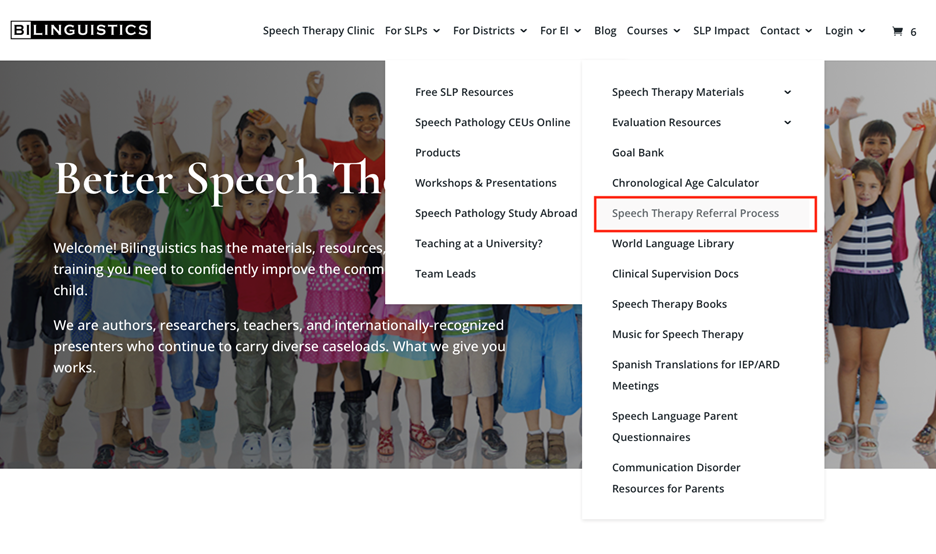
You could also just click on this link but we want you to know where to find it next time you want to use it and you don’t have the link in front of you. Here’s what you will see:
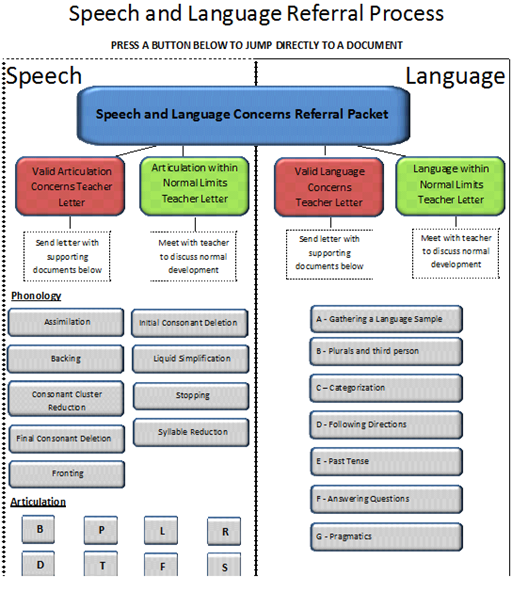
When you are in the online version, every button on this page takes you to pages that you can share with your teachers to help them gather the needed information to make informed speech referral decisions. I’ll share a couple of examples with you in this post and I encourage you to check it out for yourself. You will wish you had known about this speech referral system sooner.
The big blue button at the top takes you to a 4-page document that you can give to your teachers so you can hone in on the areas of concern. It starts with the very basics.
- Has the child’s hearing been screened?
- Does the child speak more than one language?
- Are the parents concerned?
Next, we ask in teacher friendly language whether the concerns are related to speech or language. These four pages guide us through the rest of the process.
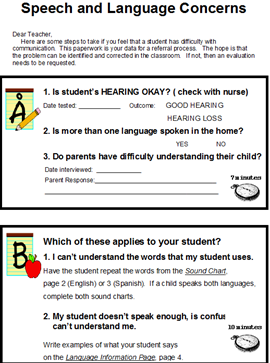

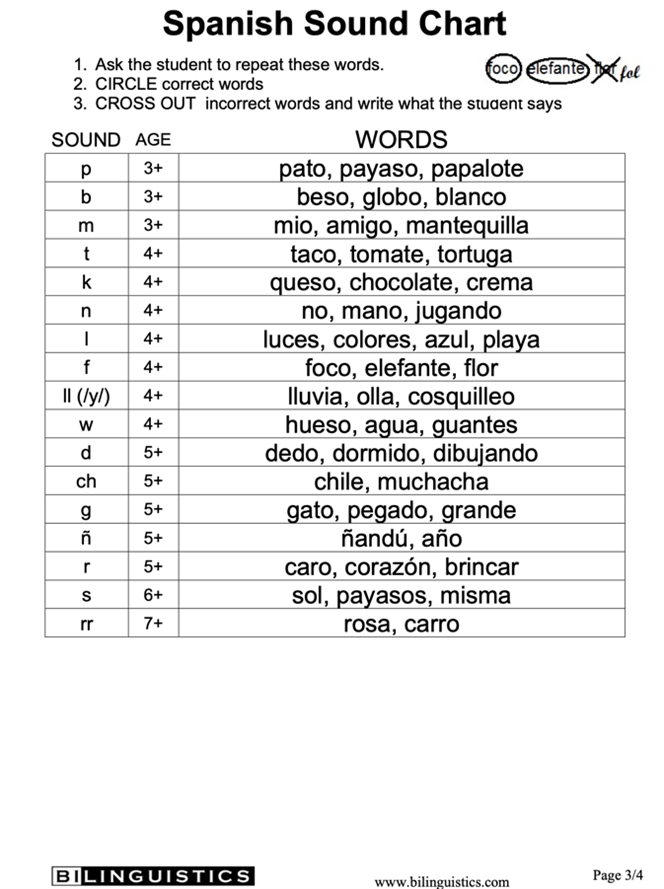
You’ll notice that on the Language Information page there is a letter corresponding with each box. Each of those has a corresponding data collection sheet that guides teachers through the process of quickly collecting student data that will us help make good referral decisions.
For example, if the teacher shares that the student has difficulty saying sentences in the correct order, we hone in on Expressive Language Syntax and go to Form A. Form A prompts the teacher to gather a short language sample using a wordless picture book or by having a conversation with the child.
The teacher can write the sentences to share with the SLP, share an audio file, or even upload the audio file into the Evalubox Language Sample Analysis to get it transcribed automatically.
Let’s look at one more example. If the teacher is concerned about the student’s ability to answer questions, we’ll look to Box F. When we click on Box F, it takes us to a 6-picture story about Cinderella with a variety of questions about the story. Again, the goal is to quickly gather data about the student’s ability to answer a variety of question types and to use that data along with parent and teacher information and other academic information to make informed decisions about the necessity of a speech referral. With a corroboration of evidence that focuses on areas of concern, as well as an eye for any linguistic or cultural influences, we can avoid referring students whose development is truly typical and get the right students in the evaluation room. This will save the districts money, reduce the caseloads of SLPs, and optimize the learning potential of students.
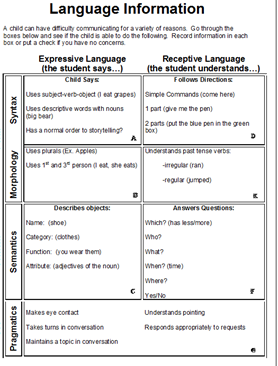
Be sure to keep an eye out for the next three parts of this series on reducing unnecessary referrals.
- Sharing our knowledge about bilingual development with our fellow educators
- Giving teachers the resources they need to gather meaningful data
- Getting quality information from parents



